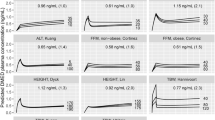Abstract
Newborn infants (21 preterm and 13 term) received dopamine infusions at a low (2.5–3.4 μg/kg per min) and/or high (5–10 μg/kg per min) infusion rate and changes in plasma catecholamines were monitored. The mean baseline values for dopamine, noradrenaline and adrenaline were between 240 and 560, 125 and 144 and 62 and 82 pg/ml, respectively. During low-rate infusion of dopamine, there was a significant increase in plasma dopamine (20–100fold), noradrenaline (three- to five-fold) and adrenaline (threefold). Administration of dopamine at the high rate resulted in an even larger increase in the plasma catecholamines (dopamine, 100–300fold; noradrenaline, seven- to eightfold; adrenaline, four- to sixfold). In a double-log plot, there was a highly significant correlation between the plasma concentrations of dopamine and noradrenaline (r=0.77;P<0.001). In conclusion, infusion of dopamine in term and preterm newborn infants is accompanied by an enhanced sympatho-adrenal tone which may contribute to the cardiovascular effects of dopamine in these patients.
Similar content being viewed by others
Abbreviations
- DHBA:
-
dihydroxybenzylamine
References
Bejrablaya D, Burn JH, Walker JM (1958) The action of sympathomimetic amines on heart rate in relation to the effect of reserpine. Br J Pharmacol 13:461–466
Driscoll DJ (1987) Use of inotropic and chronotropic agents in neonates. Clin Perinatol 14:931–949
Driscoll DJ, Gillette PC, Ezrailson EG, Schwartz A (1978) Inotropic response of the neonatal canine myocardium to dopamine. Pediatr Res 12:42–45
Driscoll DJ, Gillette PC, Lewis RM, Hartley CJ, Schwartz A (1979) Comparative hemodynamic effects of isoproterenol, dopamine, and dobutamine in the newborn dog. Pediatr Res 13:1006–1009
Goldberg L (1972) Cardiovascular and renal actions of dopamine: potential clinical applications. Pharmacol Rev 24:1–29
Gundert-Remy U, Penzien J, Hildebrandt R, Mäurer W, Weber E (1984) Correlation between the pharmacokinetics and pharmacodynamics of dopamine in healthy subjects. Eur J Clin Pharmacol 26:163–169
Harvey SC (1985) Hypnotics and sedatives. In: Gilman AG, Goodman LS, Rall TW, Murad F (eds) The pharmacological basis of therapeutics. Macmillan, New York, pp 339–371
Järnberg PO, Bengtsson L, Ekstrand J, Hamberger B (1981) Dopamine infusion in man. Plasma catecholamin levels and pharmacokinetics. Acta Anaesthesiol Scand 25:328–331
Keeley SR, Bohn DJ (1988) The use of inotropic and after-load-reducing agents in neonates. Clin Perinatol 15:467–489
Kho TL, Henquet JW, Punt R, Birkenhaeger WH, Rahn KH (1980) Influence of dobutamine and dopamine on hemodynamics and plasma concentrations of noradrenaline and renin in patients with low cardiac output following acute myocardial infarction. Eur J Clin Pharmacol 18:213–217
Nash CW, Wolff SA, Ferguson BA (1968) Release of tritiated noradrenaline from perfused rat heart by sympathomimetic amines. Can J Physiol Pharmacol 46:35–42
Padbury JF, Agata Y, Baylen BG, Ludlow JK, Polk DH, Goldblatt E, Pescetti J (1987) Dopamine pharmacokinetics in critically ill newborn infants. J Pediatr 110:293–298
Port JD, Gilbert EM, Larrabee P, Mealey P, Volkman K, Ginsburg R, Hershberger RE, Murray J, Bristow MR (1990) Neurotransmitter depletion compromises the ability of indirect-acting amines to provide inotropic support in the failing human heart. Circulation 81:929–938
Racké K, Muscholl E (1986) Release of endogenous 3,4-dihydroxyphenylethylamine and its metabolites from the isolated neurointermediate lobe of the rat pituitary gland. Effects of electrical stimulation and of inhibition of monoamine oxidase and reuptake. J Neurochem 46:745–752
Racké K, Krupa H, Schröder H, Vollrath L (1989) In vitro synthesis of dopamine and noradrenaline in the isolated rat pineal gland. Day-night variations and effects of electrical stimulation. J Neurochem 53:354–361
Ross RD, Daniels SR, Schwartz DC, Hannon DW, Shukla R, Kaplan S (1987) Plasma norepinephrine levels in infants and children with congestive heart failure. Am J Cardiol 59:911–914
Tuttle RR, Mills J (1975) Dobutamine. Development of a new catecholamine to selectively increase cardiac contractility. Circ Res 36:185–196
Zaritsky AL, Pollack MM, Schaible DH, Lake CR (1984) Dopamine infusion in pediatric patients: effects on hemodynamics and plasma catecholamines. Crit Care Med 12:214–215
Author information
Authors and Affiliations
Rights and permissions
About this article
Cite this article
Stopfkuchen, H., Racké, K., Schwörer, H. et al. Effects of dopamine infusion on plasma catecholamines in preterm and term newborn infants. Eur J Pediatr 150, 503–506 (1991). https://doi.org/10.1007/BF01958433
Received:
Accepted:
Issue Date:
DOI: https://doi.org/10.1007/BF01958433




